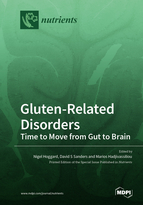Gluten-Related Disorders: Time to Move from Gut to Brain
A special issue of Nutrients (ISSN 2072-6643). This special issue belongs to the section "Nutritional Immunology".
Deadline for manuscript submissions: closed (31 December 2020) | Viewed by 69730
Special Issue Editors
Interests: Imaging of the ataxias and brain imaging in gluten related disorders
Interests: Coeliac Disease
Special Issues, Collections and Topics in MDPI journals
Interests: ataxias; neurological manifestations of coeliac disease and gluten sensitivity
Special Issues, Collections and Topics in MDPI journals
Special Issue Information
Dear Colleagues,
The extraintestinal manifestations of coeliac disease (CD) are now well recognised. We have previously edited a special issue for Nutrients covering all aspects of the extraintestinal manifestations in the context of CD. In this issue we wish to concentrate just on the neurological manifestations. The identification of TG6 autoantibodies in patients with neurological manifestations and its use in the diagnosis of such patients seems to be a good opportunity to focus on the neurological aspect of CD. In addition it is now clear that such manifestations can occur even in the absence of enteropathy but in the presence of antigliadin antibodies. Given that such antibodies can be found in up to 10% of the “healthy” population we anticipate that the neurological manifestations are likely to be very common. Apart from the well characterised neurological manifestations such as gluten ataxia, gluten neuropathy and gluten encephalopathy we would also welcome submissions that cover the whole spectrum of neurological involvement including cognitive deficits and psychiatric manifestations. We look forward to your submissions.
Prof. Nigel Hoggard
Prof. David S Sanders
Prof. Marios Hadjivassiliou
Guest Editors
Manuscript Submission Information
Manuscripts should be submitted online at www.mdpi.com by registering and logging in to this website. Once you are registered, click here to go to the submission form. Manuscripts can be submitted until the deadline. All submissions that pass pre-check are peer-reviewed. Accepted papers will be published continuously in the journal (as soon as accepted) and will be listed together on the special issue website. Research articles, review articles as well as short communications are invited. For planned papers, a title and short abstract (about 100 words) can be sent to the Editorial Office for announcement on this website.
Submitted manuscripts should not have been published previously, nor be under consideration for publication elsewhere (except conference proceedings papers). All manuscripts are thoroughly refereed through a single-blind peer-review process. A guide for authors and other relevant information for submission of manuscripts is available on the Instructions for Authors page. Nutrients is an international peer-reviewed open access semimonthly journal published by MDPI.
Please visit the Instructions for Authors page before submitting a manuscript. The Article Processing Charge (APC) for publication in this open access journal is 2900 CHF (Swiss Francs). Submitted papers should be well formatted and use good English. Authors may use MDPI's English editing service prior to publication or during author revisions.
Keywords
- Coeliac disease
- Gluten sensitivity
- Gluten ataxia
- Gluten neuropathy
- Gluten encephalopathy
- Neurological dysfunction








